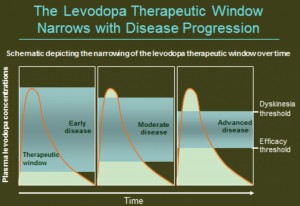By Ramon Gil, M.D. –


One of the disadvantages of levodopa is its short duration of effect. Because of this, multiple doses are required (anywhere from 3 to 6 times a day… sometimes more). This “pulsatile” stimulation of the dopamine receptors in the brain, along with progressive reduction in the production of dopamine in the brain (60 to 80% of the dopamine producing neurons are dead by the time the motor symptoms are present), are responsible factors for the onset of what is known as Motor Complications: Motor Fluctuations (MF) and Treatment Related Dyskinesias.
Problems Associated with PD
Motor Fluctuations is the term used to describe the changes between akinetic (little or no movements), often called “Off state or period,” and mobile phases: On state or period. This inability to control voluntary movements is confronted by a number of patients with PD as the disease progresses, and it is considered today as one of the most disabling problems associated with PD, becoming the number one reason for patients to seek surgical treatment (Deep Brain Stimulation or DBS) as part of their remedy.
It is estimated that 30% of the patients with PD will develop MF within two years of being treated with levodopa, and practically all patients will by 10 years on levodopa therapy.
Types of “Off States”
There are different types of “Off states,” the best and most often recognized are:
- End of dose deterioration
- Delayed onset of response or “Delayed On”
- Drug resistant “offs”
- Random oscillation (“on-off” phenomenon)
- Freezing (unpredictable inability to initiate or finish a movement)
These are all very disabling and create a great deal of functional impairment, making the patient more dependent on the primary care giver, not to talk about the associated rise in the frequency of falls and subsequent increase in morbidity and mortality.


Dyskinesias (abnormal involuntary movements of the trunk, arms, legs, neck or even facial grimacing) are also very common and could be physically and socially disabling. There are three forms of dyskinesias seen in patients with PD:
- Peak dose dyskinesias (twisting or dancing like movements affecting mainly the upper body, but could also involve the legs).
- Diphasic dyskinesias (involuntary movements involving the lower extremities).
- Off dystonias, also known as “Wearing off dystonias” (involuntary posturing of the distal part of the limbs, frequently toes) associated with increased muscle tone, spasms and quite often pain.
It has been determined that 40% of patients with PD will experience dyskinesias after one year on levodopa therapy, and the number goes up to 50% within two years. The graphic shown illustrates the problems confronted by patients in moderate to advanced stages of PD, to stay “On” with a good response to levodopa, no dyskinesias and short or minimal time “Off.”
The higher the dose of levodopa, the more intense the dyskinesias may be. The lower the dose, the less or no dyskinesias they may experience, at the expense of increased amount of “Off” time. Adjustments in the doses of medications trying to optimize the motor control become very difficult, sometimes impossible to achieve. Understandably, many patients choose surgery (DBS) to correct or minimize this rather complicated problem.
Many people claim that “patients don’t mind dyskinesias as much as they mind being Off.” This is not entirely true. In a survey conducted by the National Parkinson Foundation in 2001, 56% of patients interviewed were embarrassed because of the dyskinesias, 52% believed that “others” were embarrassed (referring to relatives, friends, physicians and/or staff). A third admitted that they avoided social interaction because of the dyskinesias, 61% reported that the dyskinesias interfered with walking and 58% claimed that this problem interfered with sleeping.
Only FDA Approved Medication to Treat Dyskinesias
Amantadine is the only FDA approved medication available to treat dyskinesias. Side effects include dizziness and lightheadedness due to low blood pressure upon standing (orthostatic hypotension), confusion, hallucinations, swelling in the feet/legs, weight gain, discoloration of the skin with a purplish mottled appearance known as “livedo reticularis.” The recommended dose is 100 mg three times a day and, in general, seems to help around 66% of the patients. A newer, once a day formulation of this drug is currently under development and phase III clinical trials are being conducted as part of the process of FDA approval. The new formulation promises to be more effective and better tolerated.
Ramon A. Gil, M.D.
Medical Director, Parkinson’s Disease
Diplomate, American Board of Psychiatry and Neurology
Parkinson’s Disease Treatment Center of SW Florida
Call 941.743.4987
 Southwest Florida's Health and Wellness Magazine Health and Wellness Articles
Southwest Florida's Health and Wellness Magazine Health and Wellness Articles

